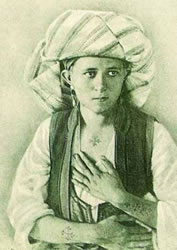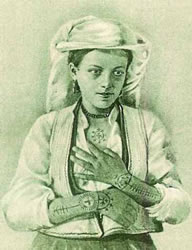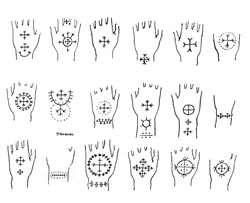Tattooing in North Africa, The Middle East and Balkans
Article © 2010 Lars Krutak
BALKAN TATTOOING
Interestingly the same tattoo motifs occur in varying degrees among several indigenous peoples in the Balkan countries of Albania, Bosnia, and Greece. Edith Durham, who traveled extensively in the region in the early 20th century, noted that “among the Moslems of North Albania tattooing is common…[they] were marked with a triangle – which forms a star and is the substitute for the rayed sun.” It is likely that these tattoos had some sort of prophylactic significance, but none was recorded by Durham because she “could only observe and make secret notes.” She did, however, see many of the tattoo designs painted on Muslim houses of the region, similar to cultural practices in northern Africa.

|
 |
Bosnian Catholic body tattooing, late 19th century. |
Durham, arguably one of the most important British writers on the culture of Albania, documented the existence of many tattooed Albanian Catholics, most of whom had migrated to the area from Bosnia to evade the Turks in the 15th century: “the bulk of these Catholic…tribes-folk, both men and women, are tattooed on the back of the hand, the forearm, or the breast with a cross; but never a plain cross. It has a crescent above and below it; or the arms terminate in small circles; or some in circles and some in crescents; or the cross is in the ‘sun-wheel’ form.” Durham stated that “most people said they did it because they were Catholics. One man remarked it was to ensure you Christian burial, if you died abroad.” When Durham asked what the meaning of the circle and crescent represented, she was told, “Dielli - the sun, and Hana - the moon. The cross was to show you were Christian.” A local priest offered, “They have a number of curious pagan beliefs which they will not tell me. I have found that they believe in two powers – Light and Darkness – which are in conflict – Good and Evil. These tattoos are in some way connected with it. So is the Serpent, which they sometimes tattoo and also draw on walls.” |
|
Today, traces of these ancient tattoos continue to be found among a small number of Bosnian Catholics, although the majority of Bosnians are Muslim. Interestingly, Durham provided us with several illustrations of the Bosnian tattoos in the same work where she describes the Albanian ones, and it is noteworthy that many of her illustrations parallel several salient elements that continue to be worn as tattoos by contemporary Bosnian women.

|
|
Bosnian Catholic tattoos, ca. 1908. |
Bosnians called the tattooing process sharati (“to color”) and many patterns were as follows: kolo (“the circle”), named after the traditional dance of the region, klas (“ear of corn”), ograda (“ring-fence”), narukvotza (“bracelet”), grancica (“small pine twig”), eliza (“fir tree”), krizh or krizhevi (cross, crosses) and more importantly Sun, Moon, and Star.
Old Bosnian Catholic women who knew the tattoo patterns worked as tattoo artists and tattoo pigment consisted of the soot of resinous pinesap collected on a plate, then combined with honey and water, saliva and mother’s milk. Sometimes tattoo designs were carved into a piece of willow bark and stenciled on the skin as a guide.
Certain days of the year were better for tattooing than others. Annunciation Day (March 25th) and Palm Sunday were tattooing days, but March 19th (St. Stephen’s Day) was the most common. According to Durham’s informants, tattooing was connected to fertility, springtime, new life, religion, and the position of the sun.
Not surprisingly, sun worship in the Balkans was an ancient pre-Christian phenomenon: the cross as a sun symbol, the four spokes representing the four quarters of the heavens and the wheel as a whole represents the movement of the sun through the heavens. Many of the Bosnian and Kurdish tattoos depict this symbol, as well as the Albanian Catholic motifs, however abstract they may be.
Next Page | 1
|
2 |
3 |
4 |
5 |
6 |
7 |
8 |
Museum photo gallery of the images
on this page may be seen here. |



